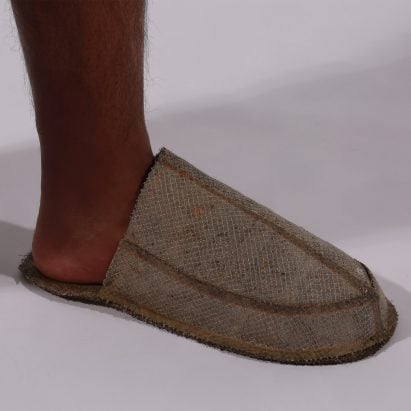Ravensbourne University graduate Rahat Rai has created a pair of slippers made using dust collected from a vacuum cleaner that was compressed to form a felt-like fabric.
The Done & Dusted project was completed by Rai during his final year of studies at Ravensbourne University in London, where he decided to focus on sustainability through the lens of material innovation.
Rahat Rai developed a material from household dust
The project explores how society might be able to reduce its reliance on new materials by identifying alternative uses for waste. Rai saw potential in household dust, which is present in every home and is treated as having no inherent value.
“I wanted to flip the script on dust,” said the designer.
“People constantly clean it up and throw it away without thinking. I decided to explore the potential of turning this overlooked, abundant waste into a usable raw material for creating something new.”
He used the material to create a pair of dust slippers
Rai collected dust from vacuum cleaners and filtered it to remove larger debris, keeping the remaining fluff intact and tangled.
He then combined the fibres, hair and dust into a sheet material by adapting a process called felting that is traditionally used to turn raw wool into fabric.
To overcome cleanliness concerns around the use of dust, Rai heat-pressed the material in an oven at a temperature of 200 degrees Celsius to kill off any mould spores, dust mites and bacteria.
This process produced a relatively weak felt that was loose and prone to shedding. To combat this issue, Rai applied a ripstop-style stitch pattern that reinforces the material while ensuring the dust remains visible.
The edges of the felted fabric were treated with latex to prevent fraying and Rai also used latex to create a moulded sole featuring a stencil of the project’s title.
The slippers have a latex sole
Rai decided to use the textile to craft a pair of slippers that showcase its potential for real-world applications, while also playfully referencing the context from which the raw material came.
“I wanted to make something meaningful,” he explained. “That’s where the house slipper came in – a product deeply tied to comfort, warmth and home. It felt poetic: something that keeps dust off your feet, now made from dust itself.”
Rai told Dezeen that the prototype dust slippers would be unlikely to withstand actual use but have successfully fulfilled their main purpose of demonstrating the material’s properties at events including the New Designers exhibition for emerging creatives.
The material itself is the main focus of the Done & Dusted project with Raj claiming that his explorative design process yielded a wide range of potential applications.
“Since people generate dust daily, this material is almost personalised, reflecting your lifestyle, habits or the things you’ve done recently,” he pointed out. “It turns an overlooked byproduct into a valuable resource to create something new, extending the life of waste meant for landfill.”
The designer intends to carry out further testing and experimentation to refine the material. He suggested that future developments could involve adding colour or introducing materials like waste wool to increase its strength.
Rai added that partnerships with cleaning companies or hotels could provide a source of raw material and said that he hopes to collaborate with companies to explore the product’s potential use in sectors like packaging and furniture.
Previous examples of footwear made from unconventional materials on Dezeen include a pair of shoes “literally made out of dirt” by Basura and Yerba Madre and the “world’s first net-zero carbon shoe”, which was made from regenerative wool.
The post Slippers made from dust showcase “meaningful” use for household waste appeared first on Dezeen.
